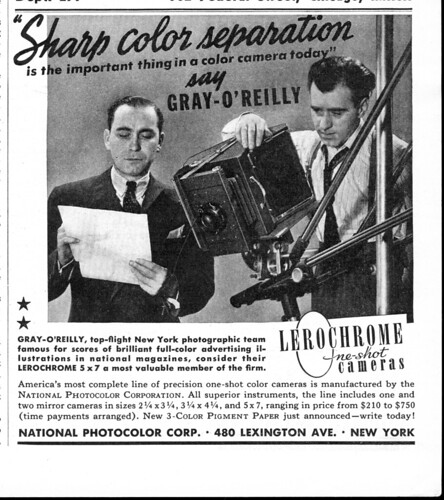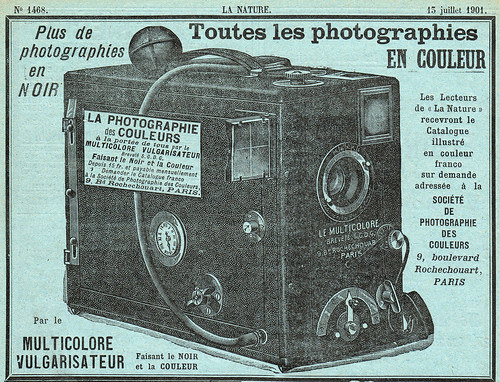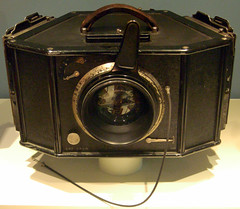Difference between revisions of "Three-color camera"
(Replaced cat (Three-color > Three-color cameras); rearranged bottom two pictures (spill when you narrow the screen); minor edit to text, link to detective camera cat.) |
m (Corrected wikilink to the plural) |
||
| Line 11: | Line 11: | ||
'''Three-color cameras''' ('''color separation cameras''') make separate monochrome negatives of the three primary-color components of the photographed image, to be used in color printing. This process precedes the invention of color plates or film. Even when colour plates such as [[Autochrome]] became available, printing from them was considerably more difficult than from color-separation negatives. Color-separation studio cameras continued to be made for demanding uses until the 1950s, twenty years after the introduction of [[Kodachrome]]. | '''Three-color cameras''' ('''color separation cameras''') make separate monochrome negatives of the three primary-color components of the photographed image, to be used in color printing. This process precedes the invention of color plates or film. Even when colour plates such as [[Autochrome]] became available, printing from them was considerably more difficult than from color-separation negatives. Color-separation studio cameras continued to be made for demanding uses until the 1950s, twenty years after the introduction of [[Kodachrome]]. | ||
| − | In early color-separation cameras, three plates are exposed sequentially, with a red, blue and green filter respectively. Clearly, this method is not appropriate for subjects that move significantly between the exposures. However, in principle, ''any'' camera can be used for this method. Cameras sold as ''three-color'' cameras are hardly different from any other camera, except that they are provided with the correct filters. Some (for example [[Dr Miethe's Dreifarben-Kamera]] by [[Bermpohl]], who specialised in cameras for this process) have a ''repeating back'' to allow the three exposures to be made in quick succession, and special dark-slides that hold a set of three plates side by side; in the [[:Category:Detective | + | In early color-separation cameras, three plates are exposed sequentially, with a red, blue and green filter respectively. Clearly, this method is not appropriate for subjects that move significantly between the exposures. However, in principle, ''any'' camera can be used for this method. Cameras sold as ''three-color'' cameras are hardly different from any other camera, except that they are provided with the correct filters. Some (for example [[Dr Miethe's Dreifarben-Kamera]] by [[Bermpohl]], who specialised in cameras for this process) have a ''repeating back'' to allow the three exposures to be made in quick succession, and special dark-slides that hold a set of three plates side by side; in the [[:Category:Detective cameras|detective camera]] shown below, the plate magazine serves the same purpose. |
In the late 1920s, cameras began to be made that make the three negatives simultaneously, extending the method to more subjects. These '''one-shot''' three-color cameras use internal arrangements of half-silvered mirrors to divide the light from the lens into three parts, and direct each part to a plate (or in later cameras, film or even digital image sensor, in such cameras as the [[Minolta RD-175]]). The three images are later combined to form a full-colour image. | In the late 1920s, cameras began to be made that make the three negatives simultaneously, extending the method to more subjects. These '''one-shot''' three-color cameras use internal arrangements of half-silvered mirrors to divide the light from the lens into three parts, and direct each part to a plate (or in later cameras, film or even digital image sensor, in such cameras as the [[Minolta RD-175]]). The three images are later combined to form a full-colour image. | ||
Revision as of 04:21, 25 January 2012

|
| Advertisement for Lerochrome 'one-shot' three-color cameras Popular Photography, February 1940. Scan by camerawiki (Image rights) |
Three-color cameras (color separation cameras) make separate monochrome negatives of the three primary-color components of the photographed image, to be used in color printing. This process precedes the invention of color plates or film. Even when colour plates such as Autochrome became available, printing from them was considerably more difficult than from color-separation negatives. Color-separation studio cameras continued to be made for demanding uses until the 1950s, twenty years after the introduction of Kodachrome.
In early color-separation cameras, three plates are exposed sequentially, with a red, blue and green filter respectively. Clearly, this method is not appropriate for subjects that move significantly between the exposures. However, in principle, any camera can be used for this method. Cameras sold as three-color cameras are hardly different from any other camera, except that they are provided with the correct filters. Some (for example Dr Miethe's Dreifarben-Kamera by Bermpohl, who specialised in cameras for this process) have a repeating back to allow the three exposures to be made in quick succession, and special dark-slides that hold a set of three plates side by side; in the detective camera shown below, the plate magazine serves the same purpose.
In the late 1920s, cameras began to be made that make the three negatives simultaneously, extending the method to more subjects. These one-shot three-color cameras use internal arrangements of half-silvered mirrors to divide the light from the lens into three parts, and direct each part to a plate (or in later cameras, film or even digital image sensor, in such cameras as the Minolta RD-175). The three images are later combined to form a full-colour image.

|
Advertisement for 'Multicolore' detective cameras with built-in filters for color separation use. Ernemann made this camera, but here it is advertised rebranded in France. La Nature, 13 July 1901. Scan by Abdishev (Image rights) |

|
| JosPe Tri-Color Camera, 1924 image by AWCam (Image rights) |
Links
- A selection of three-colour cameras by several makers at the November 2002 Westlicht Photographica Auction.
- Notes on a color portrait of Leo Tolstoy at the University of Toronto